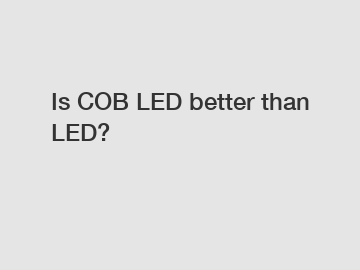Is COB LED better than LED?
Is COB LED better than LED?
Today, with the rapid advancement of technology, the lighting industry has witnessed a significant shift in the way we illuminate our surroundings. The emergence of LED (Light Emitting Diode) technology has revolutionized the field, offering energy efficiency and durability that traditional light sources couldn't match. However, with the continuous evolution of LED technology, a new contender has emerged – COB LED (Chip on Board LED). This has sparked a debate among lighting enthusiasts and professionals alike, challenging the dominance of traditional LEDs. So, the question stands: Is COB LED truly better than LED?
To answer this question, let's delve into the characteristics and attributes of both technologies, comparing their advantages and disadvantages.

1. Energy Efficiency:
LEDs are widely regarded as one of the most energy-efficient lighting solutions available today. They require significantly less power to produce the same amount of light as traditional incandescent bulbs, thus reducing energy consumption and lowering electricity bills. Likewise, COB LEDs display similar energy-saving features. However, due to the compact design and higher density of LED chips in COB LEDs, they provide even greater energy efficiency than regular LEDs.
2. Light Output and Performance:
When it comes to light output, regular LEDs and COB LEDs differ in their design. Standard LEDs consist of individual diodes, whereas COB LEDs comprise multiple diodes mounted directly on a circuit board. This distinction results in varying lighting performance. Regular LEDs offer a directional beam of light, making them suitable for applications where focused illumination is desired. In contrast, COB LEDs produce a diffused light output, spreading the beams more widely. This characteristic is favorable for applications that require even distribution of light.
3. Heat Dissipation:
One significant concern with any lighting technology is the generation of heat. Excessive heat can not only affect the performance and longevity of the light source but also pose a safety hazard. While regular LEDs are known for their excellent heat dissipation capabilities, COB LEDs outperform them in this aspect due to their larger surface area, allowing for more efficient heat dissipation. With COB LEDs, the risk of overheating is reduced, leading to improved durability and prolonged lifespan.
4. Cost and Affordability:
In the early days of LED technology, the cost of implementing LEDs posed a significant barrier for widespread adoption. However, as the technology advanced and production volumes increased, the prices have dramatically dropped, making LEDs much more affordable for consumers. On the other hand, COB LEDs, due to their more complex design and higher component density, generally come at a higher cost compared to regular LEDs. While the initial investment for COB LEDs might be higher, the long-term energy-saving benefits offset the additional expense, making them a cost-effective solution in the long run.
In conclusion, both LED and COB LED technologies have their unique advantages and applications. Regular LEDs offer excellent energy efficiency and focused illumination, making them ideal for directional lighting needs. On the other hand, COB LEDs provide enhanced energy efficiency, diffused light output, superior heat dissipation, and ultimately, a longer lifespan. COB LEDs excel in applications that require even distribution of light. However, it's worth noting that the choice between the two ultimately depends on the specific lighting requirements of a given situation. Therefore, it is essential to carefully consider the application and desired lighting effects before making a decision.
Regardless of the technology chosen, it is evident that LEDs, in general, have transformed the lighting landscape, offering countless benefits over conventional lighting solutions. As LED technology continues to evolve, we can expect to see further advancements and innovations, providing us with even more efficient, durable, and versatile lighting options for a brighter, greener future.
For more high cri cob led, 300w cob led chip supplier, cob led vs ledinformation, please contact us. We will provide professional answers.

Comments
0